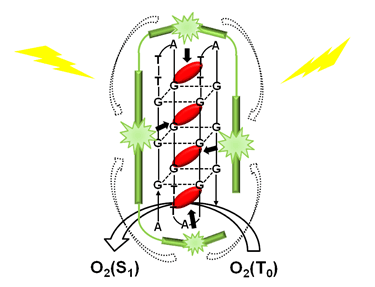| [1] Henderson, B. W.; Dougherty, T. J. Photochem. Photobiol. 1992, 55, 145.
[2] Dougherty, T. J.; Gomer, C. J.; Henderson, B. W.; Jori, G.; Kessel, D.; Korbelik, M.; Moan, J.; Peng, Q. J. Natl. Cancer Inst. 1998, 90, 889.
[3] Allen, C. M.; Sharman, W. M.; Van Lier, J. E. J. Porphyrins Phthalocyanines 2001, 5, 161.
[4] Jang, W.-D.; Nishiyama, N.; Zhang, G.-D.; Harada, A.; Jiang, D.-L.; Kawauchi, S.; Morimoto, Y.; Kikuchi, M.; Koyama, H.; Aida, T.; Kataoka, K. Angew. Chem., Int. Ed. 2005, 44, 419.
[5] Konan, Y. N.; Gurny, R.; Allémann, E. J. Photochem. Photobiol., B 2002, 66, 89.
[6] Haag, R.; Kratz, F. Angew. Chem., Int. Ed. 2006, 45, 1198.
[7] Boyle, R. W.; Dolphin, D. Photochem. Photobiol. 1996, 64, 469.
[8] Bonnett, R. Chem. Soc. Rev. 1995, 24, 19.
[9] Bonnett, R.; Martínez, G. Tetrahedron 2001, 57, 9513.
[10] DeRosa, M. C.; Crutchley, R. J. Coord. Chem. Rev. 2002, 233–234, 351.
[11] Liu, J.; Zhao, Y. W.; Zhao, J. Q.; Xia, A. D.; Jiang, L. J.; Wu, S.; Ma, L.; Dong, Y. Q.; Gu, Y. H. J. Photochem. Photobiol., B 2002, 68, 156.
[12] An, J.-Y.; Hu, Y.-Z.; Jiang, L.-J. J. Photochem. Photobiol., B 1996, 33, 261.
[13] Huang, Q.; Deng, P.; Li, Z.; Zhou, H.; Hu, X.; Pan, Z. Acta Chim. Sinica 2010, 68, 1070. (黄齐茂, 邓鹏星, 李志远, 周红, 胡学雷, 潘志权, 化学学报, 2010, 68, 1070.)
[14] Wan, Y.; Jia, K.; Li, B.; Bo, Z.; Xia, A. Sci. China Chem. 2009, 52, 56.
[15] Cheong, W.-F.; Prahl, S. A.; Welch, A. J. IEEE J. Quantum Electron. 1990, 26, 2166.
[16] Stork, M.; Gaylord, B. S.; Heeger, A. J.; Bazan, G. C. Adv. Mater. 2002, 14, 361.
[17] Wang, S.; Liu, B.; Gaylord, B. S.; Bazan, G. C. Adv. Funct. Mater. 2003, 13, 463.
[18] Wang, S.; Gaylord, B. S.; Bazan, G. C. J. Am. Chem. Soc. 2004, 126, 5446.
[19] He, F.; Tang, Y.; Wang, S.; Li, Y.; Zhu, D. J. Am. Chem. Soc. 2005, 127, 12343.
[20] Xing, C.; Xu, Q.; Tang, H.; Liu, L.; Wang, S. J. Am. Chem. Soc. 2009, 131, 13117.
[21] Bao, B.; Ma, M.; Fan, Q.; Wang, L.; Huang, W. Acta Chim. Sinica 2013, 71, 1379. (鲍碧清, 马明风, 范曲立, 汪联辉, 黄维, 化学学报, 2013, 71, 1379.)
[22] Liu, X.; Cai, X.; Huang, Y.; Shi, L.; Fan, Q.; Huang, W. Acta Chim. Sinica 2014, 72, 440. (刘兴奋, 蔡小慧, 黄艳琴, 石琳, 范曲立, 黄维, 化学学报, 2014, 72, 440.)
[23] He, G. S.; Tan, L.-S.; Zheng, Q.; Prasad, P. N. Chem. Rev. 2008, 108, 1245.
[24] Kim, H. M.; Cho, B. R. Chem. Commun. 2009, 153.
[25] Wei, C.; Jia, G.; Yuan, J.; Feng, Z.; Li, C. Biochemistry 2006, 45, 6681.
[26] Neidle, S.; Parkinson, G. N. Curr. Opin. Struct. Biol. 2003, 13, 275.
[27] Keniry, M. A. Biopolymers 2000, 56, 123.
[28] Lv, W.; Li, N.; Li, Y.; Li, Y.; Xia, A. J. Am. Chem. Soc. 2006, 128, 10281.
[29] Lipscomb, L. A.; Zhou, F. X.; Presnell, S. R.; Woo, R. J.; Peek, M. E.; Plaskon, R. R.; Williams, L. D. Biochemistry 1996, 35, 2818.
[30] Guliaev, A. B.; Leontis, N. B. Biochemistry 1999, 38, 15425.
[31] Han, F. X.; Wheelhouse, R. T.; Hurley, L. H. J. Am. Chem. Soc. 1999, 121, 3561.
[32] Vialas, C.; Pratviel, G.; Meunier, B. Biochemistry 2000, 39, 9514.
[33] Siddiqui-Jain, A.; Grand, C. L.; Bearss, D. J.; Hurley, L. H. Proc. Natl. Acad. Sci. U. S. A. 2002, 99, 11593.
[34] Seenisamy, J.; Rezler, E. M.; Powell, T. J.; Tye, D.; Gokhale, V.; Joshi, C. S.; Siddiqui-Jain, A.; Hurley, L. H. J. Am. Chem. Soc. 2004, 126, 8702.
[35] Dixon, I. M.; Lopez, F.; Estève, J.-P.; Tejera, A. M.; Blasco, M. A.; Pratviel, G.; Meunier, B. ChemBioChem 2005, 6, 123.
[36] Seenisamy, J.; Bashyam, S.; Gokhale, V.; Vankayalapati, H.; Sun, D.; Siddiqui-Jain, A.; Streiner, N.; Shin-ya, K.; White, E.; Wilson, W. D.; Hurley, L. H. J. Am. Chem. Soc. 2005, 127, 2944.
[37] Dixon, I. M.; Lopez, F.; Tejera, A. M.; Estève, J.-P.; Blasco, M. A.; Pratviel, G.; Meunier, B. J. Am. Chem. Soc. 2007, 129, 1502.
[38] Joachimi, A.; Mayer, G.; Hartig, J. S. J. Am. Chem. Soc. 2007, 129, 3036.
[39] Zhang, X.; Chen, C. Acta Chim. Sinica 2012, 70, 2475. (张现侠, 陈灿玉, 化学学报, 2012, 70, 2475.)
[40] Pasternack, R. F.; Gibbs, E. J.; Villafranca, J. J. Biochemistry 1983, 22, 2406.
[41] Pasternack, R. F.; Gibbs, E. J.; Villafranca, J. J. Biochemistry 1983, 22, 5409.
[42] Anderson, M. n. E.; Barrett, A. G. M.; Hoffman, B. M. J. Inorg. Biochem. 2000, 80, 257.
[43] Tan, C.; Atas, E.; Müller, J. G.; Pinto, M. R.; Kleiman, V. D.; Schanze, K. S. J. Am. Chem. Soc. 2004, 126, 13685.
[44] Frederiksen, P. K.; McIlroy, S. P.; Nielsen, C. B.; Nikolajsen, L.; Skovsen, E.; Jørgensen, M.; Mikkelsen, K. V.; Ogilby, P. R. J. Am. Chem. Soc. 2005, 127, 255.
[45] Briñas, R. P.; Troxler, T.; Hochstrasser, R. M.; Vinogradov, S. A. J. Am. Chem. Soc. 2005, 127, 11851.
[46] Chen, C.-Y.; Tian, Y.; Cheng, Y.-J.; Young, A. C.; Ka, J.-W.; Jen, A. K. Y. J. Am. Chem. Soc. 2007, 129, 7220.
[47] Crosby, G. A.; Demas, J. N. J. Phys. Chem. 1971, 75, 991.
[48] Chen, F.; Zhang, W.; Jia, M.; Wei, L.; Fan, X.-F.; Kuo, J.-L.; Chen, Y.; Chan-Park, M. B.; Xia, A.; Li, L.-J. J. Phys. Chem. C 2009, 113, 14946.
[49] Bonnett, R.; McGarvey, D. J.; Harriman, A.; Land, E. J.; Truscott, T. G.; Winfield, U. J. Photochem. Photobiol. 1988, 48, 271.
[50] Drobizhev, M.; Stepanenko, Y.; Dzenis, Y.; Karotki, A.; Rebane, A.; Taylor, P. N.; Anderson, H. L. J. Am. Chem. Soc. 2004, 126, 15352.
[51] Xu, C.; Webb, W. W. J. Opt. Soc. Am. B 1996, 13, 481.
[52] Rumi, M.; Ehrlich, J. E.; Heikal, A. A.; Perry, J. W.; Barlow, S.; Hu, Z.; McCord-Maughon, D.; Parker, T. C.; Röckel, H.; Thayumanavan, S.; Marder, S. R.; Beljonne, D.; Brédas, J.-L. J. Am. Chem. Soc. 2000, 122, 9500. |
